IEEE(CS)格式
IEEE标准格式

IEEE标准格式论文题目(使用格式:论文标题)根据需要加的副标题第一隶属关系者姓名(第一作者姓名)第一行(作者隶属关系的):部、组织名称第二行:组织名称、可接受的缩写第三行:城市、国家第二联系者姓名(第二作者姓名)第一行(作者隶属关系的):部、组织名称第二行:组织名称、可接受的缩写第三行:城市、国家摘要——这个电子文档就是一个“活”的模板。
论文的各个组成部分(标题,文字,页眉等)已经被定义在格式表上,本文中将对部分内容进行介绍。
在论文的标题、摘要中不要使用特殊字符、特殊符号或者数学符号。
(摘要) 关键字——组成部分;格式;类型;样式;插入(关键字)一、引言(标题1)所有的稿件必须用英文书写。
本文中的这些准则包括字体,间距及出版论文全文的相关信息的完整描述。
请遵循这些准则,如果你有任何问题,请直接到会议出版服务(CPS)处询问负责你论文出版的编辑。
联系电话:+1(714)821-8380,传真:+1(714)761-1784。
此模板给准备论文电子版的作者提供了其所需的许多格式规范。
所有标准论文组件从三分方面指定:(1)方便个人论文规范化;(2)自觉遵守便于目前或以后出版电子稿论文的需求;(3)会议论文集中使用统一的格式、页边距、列宽、行距和内置的格式样式;该文章列举了格式样式的例子,例子在括号内用斜体字进行标注,请遵循例子的格式。
请不要重置页边距。
像多次方程、图形及表格类的论文组成部分,本文并没有给出规定,但给出了不同的图标文本类型。
有必要时可更改这些格式,并制定需要遵循的适用标准。
二、论文格式及字体无论何处用到Times字体时,都需要用Times Roman或Times New Roman字体。
如果文字处理器没有这两种字体,请选择外观与Times字体相近的字体。
应尽可能地避免使用位图字体,首选使用True-Type1或Open Type字体。
对于数学公式等,请使用公式编辑器将其插入。
三、使用说明A、选择一个模板(标题2)首先,要确保选择一个与自己论文尺寸相符的合适的模板,且该模板应符合美国论文打印的论文纸的规格。
生医论文写作根据「科学编辑委员会cse」格式手册的文法解说

生医论文写作根据「科学编辑委员会cse」格式手册的文法解说冒号(colon)1.冒号是用来引述一句长的引言。
2.冒号是用来引述一个列表(系列)。
3.冒号前的句子组成部分必须是完整的独立子句。
•正确:the lectures covered 3 topics:carbohydrates, lipids, and proteins.•错误:the lectures covered: carbohydrates, lipids, and proteins.分号(semicolon)分号不能用于「和(and)」之前。
•正确:the nurse removed the sutures, and thepatient was discharged.•错误:the nurse removed the sutures; and thepatient was discharged.不使用逗号(ma)的情况1. 切勿使用逗号来隔开限定性同位语。
•正确:the species bombyx mori is distinguishedfrom . . .•错误:the species, bombyx mori, is distinguishedfrom . . .2. 当文意已经清楚明确时,切勿使用逗号来隔开两个由对等连接词所连结的简短独立子句。
•正确:the survey was pleted and we went home.•错误:the survey was pleted, and we went home.3. 切勿使用逗号来隔开页码、地址号码、年份号码或登录号码里的个别数字。
4. 针对含有五个数位以上的数字,切勿透过逗号以三个数位为一组的方式将数字隔开,而是该使用「窄空格(thin space)」。
•正确:12 578 896•错误:12,578,896说明:使用microsoft word来插入窄空格,点选「 insert–symbol—more symbol」(插入–符号–更多符号)。
CMS和CSE_格式

CMS Author-Date Style,CSE Systems: Name-Year(N-Y) & Citation-Sequence(C-S)1.正文中的引证CMS Author-Date, N-Y两种格式注明出处时使用括号夹注的方法;C-S格式使用数字标注的方法。
(1)引用整篇文献的观点引用整篇文献(即全书或全文)观点时有两种情况,一种是作者的姓氏在正文中没有出现,如:CMS author-date:This procedure has been used successfully (Wong and Murphy 2001).N-Y:This procedure has been used successfully (Wong and Murphy 2001).C-S:This procedure has been used successfully[1].另一种情况是作者的姓氏已在正文同一句中出现,不需要使用括号夹注,如:CMS author-date:Wong and Murphy (2001) have used this procedure successfully.N-Y:Wong and Murphy (2001) have used this procedure successfully.在英文撰写的论文中引用中文著作或期刊,括号夹注中只需用汉语拼音标明作者的姓氏,不得使用汉字,如:(Zhu2000)(2)引用文献中具体观点或文字引用文献中某一具体观点或文字时必须注明该观点或者该段文字出现的页码,没有页码是文献引用不规范的表现。
例如:CMS author-date:The results have been called “poppycock ” (Wilson 2009,70).Wilson (2009, 70) has called the results “poppycock.”Wilson (2009) has called the results “poppycock”(70).N-Y:The results have been called “poppycock ” (Wilson 2009, p 70).Wilson (2009, p 70) has called the results “poppycock.”Wilson (2009) has called the results “poppycock”(p 70).如是同一作者的多卷本,则应在页码前加卷数,如是一本书的其中一个章节,则应加章节号,如是引用的图表,则应标注图表号。
IEEE Computer Society (IEEE CS) 全文期刊(23种)列表及简介
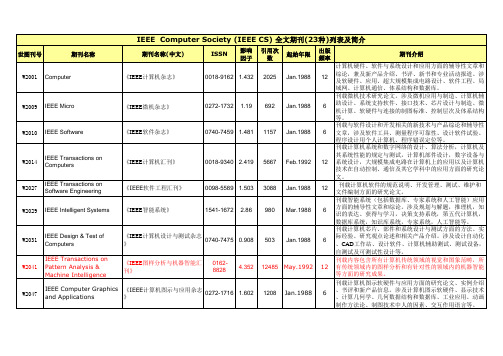
0272-1716 1.602
1208
Jan.1988
6
IEEE Computer Society (IEEE CS) 全文期刊(23种)列表及简介
世图刊号 W2050 期刊名称 IEEE Transactions on Knowledge & Data Engineering IEEE Pervasive Computing 期刊名称(中文) 《IEEE知识与数据工程汇刊 》 ISSN 影响 因子 引用次 数 1559 起始年限 Mar.1989 出版 频率 12 期刊介绍 发表计算机科学与工程、人工智能、电气工程等相关的 知识与数据系统的研究、设计和开发成果。 所谓后PC时代是指计算机无所不在,它渗透到我们工作 和生活的方方面面。移动互联网接入、第3代无线通讯、 便携式装置及蓝牙技术的流行使我们进入了后PC时代, 本刊旨在帮助读者获得移动数据处理、无线网络、安全 、可伸缩性、智能运输工具与环境以及分布式数据处理 应用的最新信息。 发表移动信息处理技术、无线网络、可靠性与质量保证 、分布式系统结构、高级规程方面的研究论文。 刊载计算机科学与技术在生物学、化学、物理学等领域 的应用与研究进展。 刊载了计算机互联网方面的技术知识。 刊载多媒体计算与通信系统方面的论文,涉及用于媒体 压缩的软硬件、媒体存贮与传输、工作站支援、数据模 型建立、应用程序中嵌入多媒体的提取等内容。 刊载有关并行与分布计算系统的软硬件及其应用研究论 文与评论。涉及体系结构包括多处理机系统的设计、分 析和实现,超大规模集成电路对设计的影响;软件包括 语言与编译程序、程序设计条件;并行算法与应用;性 能检测、评价与模拟。 集科技可视化与计算机图示学、信号处理、计算机辅助 设计、用户界面于一体。全面介绍可视化技术、流程形 象化、透视图、动画片制作等。 刊载与计算机信息技术内容相关的内容。 刊载计算机安全与保密方面的内容。 刊载以复杂生物资料和计算生物学为核心的数学、统计 学等计算方法的研究结果;关于复杂生物资料方面的有 效计算机程序的发展和测试;生物学数据库的发展和优 化;通过使用相关计算方法、程式和数据库得到的重要 的生物学成果。
ieee参考文献格式
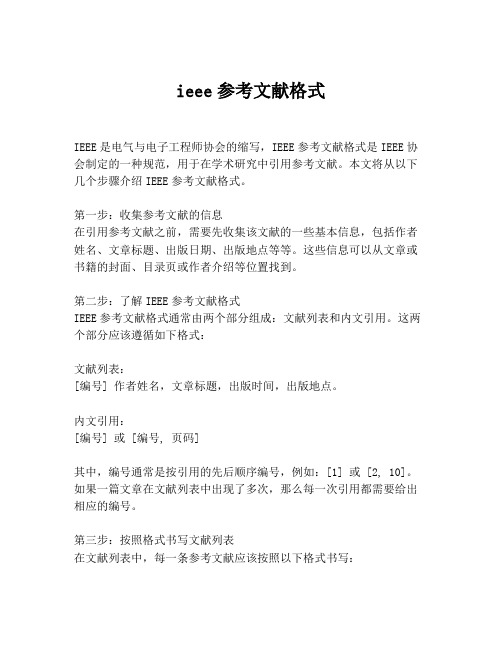
ieee参考文献格式IEEE是电气与电子工程师协会的缩写,IEEE参考文献格式是IEEE协会制定的一种规范,用于在学术研究中引用参考文献。
本文将从以下几个步骤介绍IEEE参考文献格式。
第一步:收集参考文献的信息在引用参考文献之前,需要先收集该文献的一些基本信息,包括作者姓名、文章标题、出版日期、出版地点等等。
这些信息可以从文章或书籍的封面、目录页或作者介绍等位置找到。
第二步:了解IEEE参考文献格式IEEE参考文献格式通常由两个部分组成:文献列表和内文引用。
这两个部分应该遵循如下格式:文献列表:[编号] 作者姓名,文章标题,出版时间,出版地点。
内文引用:[编号] 或 [编号, 页码]其中,编号通常是按引用的先后顺序编号,例如:[1] 或 [2, 10]。
如果一篇文章在文献列表中出现了多次,那么每一次引用都需要给出相应的编号。
第三步:按照格式书写文献列表在文献列表中,每一条参考文献应该按照以下格式书写:[编号] 作者姓名,“文章标题”,期刊名称,卷号,第几期,页码,出版时间。
对于专利、会议论文、书籍等类型的文献,应该按照相应的格式书写。
需要注意的是,作者姓名应该按照“姓氏”、“名字”的顺序排列。
第四步:按照格式书写内文引用在正文中引用某篇参考文献时,需要插入一个方括号和相应的编号,例如:[1] 或 [2, 10]。
在插入方括号后,一定要注意选择合适的位置,以避免影响文章的阅读与理解。
第五步:排版与定稿写完文献列表和内文引用后,需要经过排版和定稿才算完成。
在排版时,应该按照IEEE参考文献格式的要求进行排版,避免出现错误。
在定稿时,可以请同行专家或编辑进行审核,以确保文献的准确性和规范性。
总结:细心和耐心是书写IEEE参考文献格式的重要素质。
只有在收集信息、理解规范和认真书写的基础上,才能写出符合行业标准的参考文献格式。
希望这篇文章能够帮助读者更好地理解和应用IEEE参考文献格式。
ieee引用缩写格式
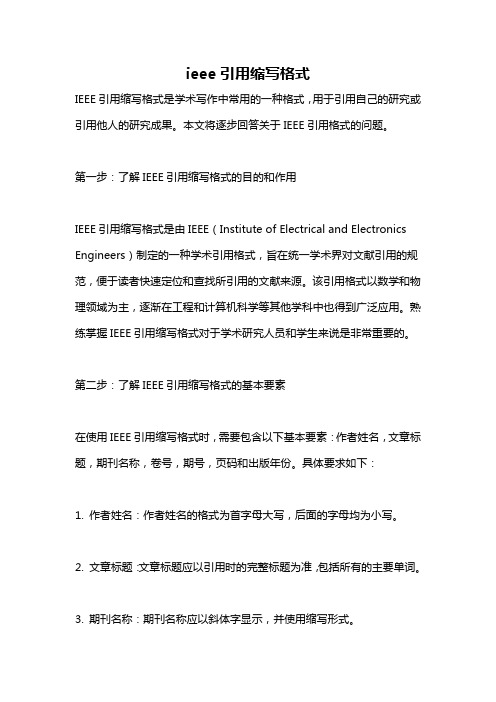
ieee引用缩写格式IEEE引用缩写格式是学术写作中常用的一种格式,用于引用自己的研究或引用他人的研究成果。
本文将逐步回答关于IEEE引用格式的问题。
第一步:了解IEEE引用缩写格式的目的和作用IEEE引用缩写格式是由IEEE(Institute of Electrical and Electronics Engineers)制定的一种学术引用格式,旨在统一学术界对文献引用的规范,便于读者快速定位和查找所引用的文献来源。
该引用格式以数学和物理领域为主,逐渐在工程和计算机科学等其他学科中也得到广泛应用。
熟练掌握IEEE引用缩写格式对于学术研究人员和学生来说是非常重要的。
第二步:了解IEEE引用缩写格式的基本要素在使用IEEE引用缩写格式时,需要包含以下基本要素:作者姓名,文章标题,期刊名称,卷号,期号,页码和出版年份。
具体要求如下:1. 作者姓名:作者姓名的格式为首字母大写,后面的字母均为小写。
2. 文章标题:文章标题应以引用时的完整标题为准,包括所有的主要单词。
3. 期刊名称:期刊名称应以斜体字显示,并使用缩写形式。
4. 卷号和期号:卷号和期号分别以卷和号作为前缀,并使用阿拉伯数字。
5. 页码:页码采用“起始页码-结束页码”的格式。
6. 出版年份:出版年份使用阿拉伯数字,与其他信息之间用逗号分隔。
第三步:使用IEEE引用缩写格式引用期刊文章在引用期刊文章时,需要按照以下格式进行引用:[作者姓名], "[文章标题],"[期刊名称],vol.[卷号], no.[期号], p.[起始页码]-[结束页码], [出版年份]."例如:[1] J. K. Author, “Title of paper,”IEEE Trans. on XYZ, vol. 34, no. 5, pp. 123-456, May 2019.第四步:使用IEEE引用缩写格式引用会议文章在引用会议文章时,需要按照以下格式进行引用:[作者姓名], "[文章标题],"[会议名称],pp.[起始页码]-[结束页码], [出版地点], [出版年份]."例如:[2] C. D. Author, “Title of paper,”in Proc. of IEEE Int. Conf. on ABC, pp. 789-890, New York, NY, USA, 2020.第五步:使用IEEE引用缩写格式引用电子文献在引用电子文献时,需要按照以下格式进行引用:[作者姓名], “[文章标题],”[期刊名称],vol. [卷号], no. [期号], pp. [起始页码]-[结束页码], [在线来源], [访问日期].例如:[3] E. F. Author, “Title of paper,”IEEE Trans. on XYZ, vol. 12, no. 3, pp. 56-78, Available: Accessed: May 10, 2021.第六步:补充说明在使用IEEE引用缩写格式时,还需要注意以下几点:1. 如果期刊名称可以完整写出并且辨识度很高,可以省略卷号和期号。
ieee参考文献格式要求
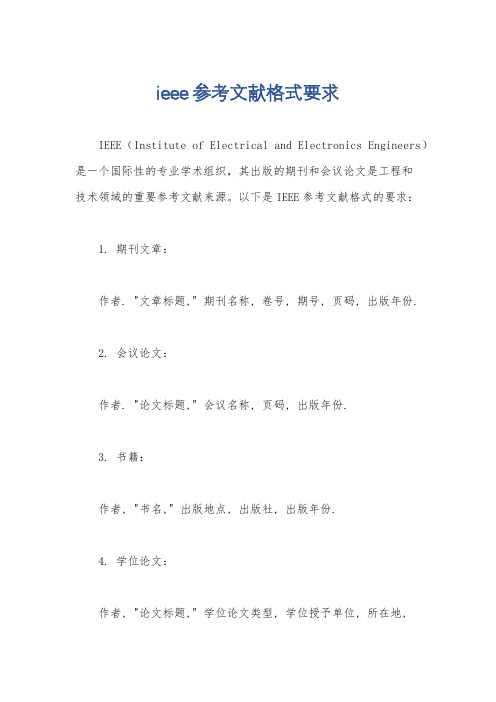
ieee参考文献格式要求
IEEE(Institute of Electrical and Electronics Engineers)是一个国际性的专业学术组织,其出版的期刊和会议论文是工程和
技术领域的重要参考文献来源。
以下是IEEE参考文献格式的要求:
1. 期刊文章:
作者. "文章标题," 期刊名称, 卷号, 期号, 页码, 出版年份.
2. 会议论文:
作者. "论文标题," 会议名称, 页码, 出版年份.
3. 书籍:
作者, "书名," 出版地点, 出版社, 出版年份.
4. 学位论文:
作者, "论文标题," 学位论文类型, 学位授予单位, 所在地,
年份.
5. 报告:
作者, "报告标题," 报告类型, 报告号, 出版地点, 出版机构, 出版年份.
6. 网络资源:
作者(如果有), "文档标题," 网站名称, 网址, 访问日期.
需要注意的是,以上仅是IEEE参考文献格式的基本要求,具体的格式还取决于文献类型和出版物的要求。
在引用参考文献时,应该使用数字标注法,将文献引用编号放在方括号内,按照引用的顺序编排。
此外,IEEE还有一些特殊情况的参考文献格式要求,如专利、标准、手册等,可以在IEEE官方网站或相关文献样例中找到详细的说明和示例。
总之,遵循IEEE参考文献格式的要求可以确保文献引用的准确性和规范性,有助于读者准确找到引用的文献来源。
ieee论文格式
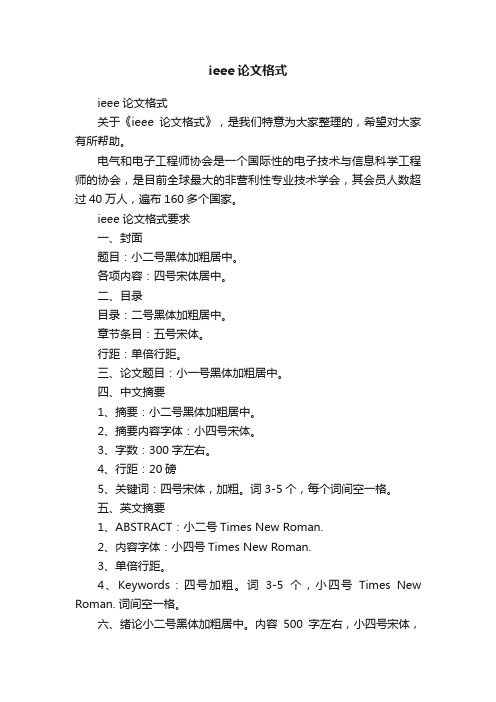
ieee论文格式ieee论文格式关于《ieee论文格式》,是我们特意为大家整理的,希望对大家有所帮助。
电气和电子工程师协会是一个国际性的电子技术与信息科学工程师的协会,是目前全球最大的非营利性专业技术学会,其会员人数超过40万人,遍布160多个国家。
ieee论文格式要求一、封面题目:小二号黑体加粗居中。
各项内容:四号宋体居中。
二、目录目录:二号黑体加粗居中。
章节条目:五号宋体。
行距:单倍行距。
三、论文题目:小一号黑体加粗居中。
四、中文摘要1、摘要:小二号黑体加粗居中。
2、摘要内容字体:小四号宋体。
3、字数:300字左右。
4、行距:20磅5、关键词:四号宋体,加粗。
词3-5个,每个词间空一格。
五、英文摘要1、ABSTRACT:小二号Times New Roman.2、内容字体:小四号Times New Roman.3、单倍行距。
4、Keywords:四号加粗。
词3-5个,小四号Times New Roman. 词间空一格。
六、绪论小二号黑体加粗居中。
内容500字左右,小四号宋体,行距:20磅七、正文(一)正文用小四号宋体(二)安保、管理类毕业论文各章节按照一、二、三、四、五级标题序号字体格式章:标题小二号黑体,加粗,居中。
节:标题小三号黑体,加粗,居中。
一级标题序号如:一、二、三、标题四号黑体,加粗,顶格。
二级标题序号如:(一)(二)(三) 标题小四号宋体,不加粗,顶格。
三级标题序号如:1.2.3. 标题小四号宋体,不加粗,缩进二个字。
四级标题序号如:(1)(2)(3) 标题小四号宋体,不加粗,缩进二个字。
五级标题序号如:①②③ 标题小四号宋体,不加粗,缩进二个字。
医学、体育类毕业论文各章序号用阿拉伯数字编码,层次格式为:1××××(小2号黑体,居中)××××××××& times;×××××(内容用4号宋体)。
IEEE Computer Society (IEEE CS) 全文期刊(23种)列表及简介

W2001
Computer
《IEEE计算机杂志》
0018-9162 1.432
Jan.1988
W2009
IEEE Micro
《IEEE微机杂志》
0272-1732
1.19
692
Jan.1988
6
W2010
IEEE Software
《IEEE软件杂志》
0740-7459 1.481
1157
Jan.1988
0098-5589 1.503
3088
Jan.1988
12
W2029
《IEEE智能系统》
1541-1672
2.86
980
Mar.1988
6
W2031
IEEE Design & Test of Computers IEEE Transactions on Pattern Analysis & Machine Intelligence
《IEEE移动计算汇刊》 《IEEE科学与工程计算杂志 》 《IEEE互联网计算杂志》 《IEEE多媒体杂志》
1536-1233 1521-9615 0.75 341 806 424
Jan.2002 Mar.1994 Jan.1997 Mar.1994
12 6 6 4
1089-7801 2.554 1070-986X 1.243
Mar.1995 Jan.1999 Jan.2003
6 6 6
W2128
《IEEE-ACM计算生物学与生 1545-5963 物信息学汇刊》
Jan.2004
4
IEEE Computer Society (IEEE CS) 全文期刊(23种)列表及简介
ieee参考文献标准

ieee参考文献标准
IEEE参考文献标准指的是IEEE(电气电子工程师协会)制定的参考文献引用格式规范。
该标准主要用于学术论文、技术报告、会议论文等科技文献的引用格式规范,以促进文献引用的一致性和准确性。
IEEE参考文献标准包括以下几个方面:
1. 参考文献的引用格式:IEEE参考文献标准规定了不同类型文献的引用格式,包括期刊论文、会议论文、专利文献、技术报告等。
2. 作者姓名和姓氏的写法:要求作者姓在前,名在后,姓氏用全称,名用缩写,并使用逗号分隔。
3. 出版物名称的写法:要求出版物名称用全称,并使用斜体字表示。
4. 出版日期和卷号的写法:要求出版日期用公历年份表示,卷号用阿拉伯数字表示,并使用逗号分隔。
5. 页码的写法:要求页码用阿拉伯数字表示,并放在圆括号内。
在使用IEEE参考文献标准时,需要注意以下几点:
1. 引用文献要与文中内容相关,避免出现文不对题的情况。
2. 引用文献要按照文中出现的顺序依次列出,并在文后按照文中出现的顺序依次列出。
3. 引用文献中的作者姓名、出版物名称、出版日期等要与原文一致,避免出现误差。
4. 在文中的引用处要用上标标注参考文献的序号,序号要用圆括号括起来。
5. 在文后参考文献表中列出所有引用的文献,并按文中出现的顺序依次列出。
ieee引文格式

ieee引文格式IEEE文中引用规则IEEE格式规定在论文中使用方括号和数字引用文献。
这些参考文献按照它们在文中出现的顺序编号,并应完整准确地对应于论文末尾参考文献列表中的参考文献。
在IEEE格式中,文内引用(in-text citations)应该出现在句末和在句号之前。
参考文献的编号放在方括号内,而且在数字与句子之间没有标点符号,例如:[1] states that the use of renewable energy sources is increasing.当在一句中引用多个文献时,参考文献的编号之间用逗号和空格分隔,例如:Several studies [1, 2, 3] have shown the benefits of using renewable energy sources.IEEE引用格式要求在文中引用的每条参考文献都必须完整出现在文末的参考文献列表中。
IEEE文中引用示例文中的参考文献在文末参考文献列表中的所有文献都必须在文中被引用。
在引用文献时,文献编号出现在方括号中,并出现在标点符号之前。
从语法上讲,被引用的参考文献的编号可被视为脚注编号(footnote number),例如:…as shown by Brown [4], [5]; as mentioned earlier [2], [4]–[7], [9]; Kwon [4] and Thalin and Peters [5]; Park et al. [7]从上例中可以注意到,当文中引用的作者姓名有三个或三个以上时,需要使用et al.。
还有是下面这种直接用作名词的:…as demonstrated in [3]; according to [4] and [6]–[9].以下是IEEE引用格式的更多示例:According to a recent study [1], the use of renewable energy sources has increased significantly in the past decade.The benefits of using renewable energy sources include reduced greenhouse gas emissions [2] and decreased dependence on non-renewable sources [3].In a survey of 1000 individuals, 80% agreed that it is important to invest in renewable energy [4].方括号内的参考文献编号应当对应于论文末尾参考文献列表中的文献编号。
IEEE 论文格式
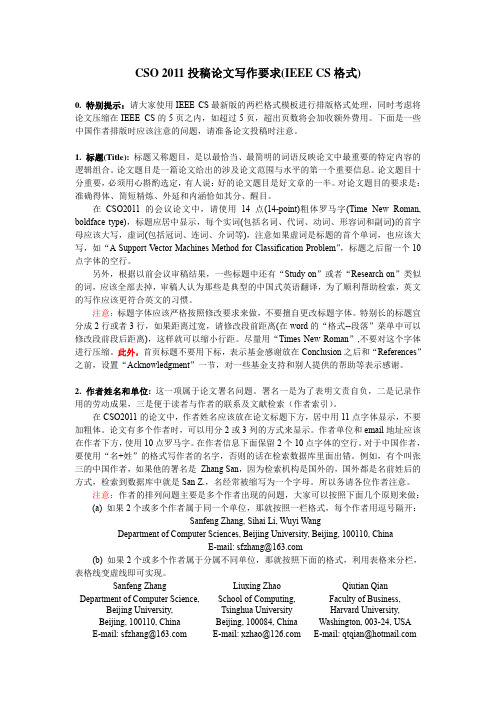
CSO 2011投稿论文写作要求(IEEE CS格式)0. 特别提示:请大家使用IEEE CS最新版的两栏格式模板进行排版格式处理,同时考虑将论文压缩在IEEE CS的5页之内,如超过5页,超出页数将会加收额外费用。
下面是一些中国作者排版时应该注意的问题,请准备论文投稿时注意。
1. 标题(Title):标题又称题目,是以最恰当、最简明的词语反映论文中最重要的特定内容的逻辑组合。
论文题目是一篇论文给出的涉及论文范围与水平的第一个重要信息。
论文题目十分重要,必须用心斟酌选定,有人说:好的论文题目是好文章的一半。
对论文题目的要求是:准确得体、简短精炼、外延和内涵恰如其分、醒目。
在CSO2011的会议论文中,请使用14点(14-point)粗体罗马字(Time New Roman, boldface type),标题应居中显示,每个实词(包括名词、代词、动词、形容词和副词)的首字母应该大写,虚词(包括冠词、连词、介词等),注意如果虚词是标题的首个单词,也应该大写,如“A Support Vector Machines Method for Classification Problem”,标题之后留一个10点字体的空行。
另外,根据以前会议审稿结果,一些标题中还有“Study on”或者“Research on”类似的词,应该全部去掉,审稿人认为那些是典型的中国式英语翻译,为了顺利帮助检索,英文的写作应该更符合英文的习惯。
注意:标题字体应该严格按照修改要求来做,不要擅自更改标题字体。
特别长的标题宜分成2行或者3行,如果距离过宽,请修改段前距离(在word的“格式--段落”菜单中可以修改段前段后距离),这样就可以缩小行距。
尽量用“Times New Roman”,不要对这个字体进行压缩。
此外,首页标题不要用下标,表示基金感谢放在Conclusion之后和“References”之前,设置“Acknowledgment”一节,对一些基金支持和别人提供的帮助等表示感谢。
IEEE参考文献格式

•Creating a reference list or bibliographyA numbered list of references must be provided at the end of thepaper. The list should be arranged in the order of citation in the text of the assignment or essay, not in alphabetical order. List only one reference per reference number. Footnotes or otherinformation that are not part of the referencing format should not be included in the reference list.The following examples demonstrate the format for a variety of types of references. Included are some examples of citing electronic documents. Such items come in many forms, so only some examples have been listed here.Print DocumentsBooksNote: Every (important) word in the title of a book or conference must be capitalised. Only the first word of a subtitle should be capitalised. Capitalise the "v" in Volume for a book title.Punctuation goes inside the quotation marks.Standard formatSingle author[1] W.-K. Chen, Linear Networks and Systems. Belmont, CA: Wadsworth,1993, pp. 123-135.[2] S. M. Hemmington, Soft Science. Saskatoon: University ofSaskatchewan Press, 1997.Edited work[3] D. Sarunyagate, Ed., Lasers. New York: McGraw-Hill, 1996.Later edition[4] K. Schwalbe, Information Technology Project Management, 3rd ed.Boston: Course Technology, 2004.[5] M. N. DeMers, Fundamentals of Geographic Information Systems,3rd ed. New York : John Wiley, 2005.More than one author[6] T. Jordan and P. A. Taylor, Hacktivism and Cyberwars: Rebelswith a cause? London: Routledge, 2004.[7] U. J. Gelinas, Jr., S. G. Sutton, and J. Fedorowicz, Businessprocesses and information technology. Cincinnati:South-Western/Thomson Learning, 2004.Three or more authorsNote: The names of all authors should be given in the references unless the number of authors is greater than six. If there are more than six authors, you may use et al. after the name of the first author.[8] R. Hayes, G. Pisano, D. Upton, and S. Wheelwright, Operations,Strategy, and Technology: Pursuing the competitive edge.Hoboken, NJ : Wiley, 2005.Series[9] M. Bell, et al., Universities Online: A survey of onlineeducation and services in Australia, Occasional Paper Series 02-A. Canberra: Department of Education, Science andTraining, 2002.Corporate author (ie: a company or organisation)[10] World Bank, Information and Communication Technologies: AWorld Bank group strategy. Washington, DC : World Bank, 2002.Conference (complete conference proceedings)[11] T. J. van Weert and R. K. Munro, Eds., Informatics and theDigital Society: Social, ethical and cognitive issues: IFIP TC3/WG3.1&3.2 Open Conference on Social, Ethical andCognitive Issues of Informatics and ICT, July 22-26, 2002, Dortmund, Germany. Boston: Kluwer Academic, 2003.Government publication[12] Australia. Attorney-Generals Department. Digital AgendaReview, 4 Vols. Canberra: Attorney- General's Department,2003.Manual[13] Bell Telephone Laboratories Technical Staff, TransmissionSystem for Communications, Bell Telephone Laboratories,1995.Catalogue[14] Catalog No. MWM-1, Microwave Components, M. W. Microwave Corp.,Brooklyn, NY.Application notes[15] Hewlett-Packard, Appl. Note 935, pp. 25-29.Note:Titles of unpublished works are not italicised or capitalised. Capitalise only the first word of a paper or thesis.Technical report[16] K. E. Elliott and C.M. Greene, "A local adaptive protocol,"Argonne National Laboratory, Argonne, France, Tech. Rep.916-1010-BB, 1997.Patent / Standard[17] K. Kimura and A. Lipeles, "Fuzzy controller component, " U.S. Patent 14,860,040, December 14, 1996.Papers presented at conferences (unpublished)[18] H. A. Nimr, "Defuzzification of the outputs of fuzzycontrollers," presented at 5th International Conference onFuzzy Systems, Cairo, Egypt, 1996.Thesis or dissertation[19] H. Zhang, "Delay-insensitive networks," M.S. thesis,University of Waterloo, Waterloo, ON, Canada, 1997.[20] M. W. Dixon, "Application of neural networks to solve therouting problem in communication networks," Ph.D.dissertation, Murdoch University, Murdoch, WA, Australia, 1999.Parts of a BookNote: These examples are for chapters or parts of edited works in which the chapters or parts have individual title and author/s, but are included in collections or textbooks edited by others. If the editors of a work are also the authors of all of the included chapters then it should be cited as a whole book using the examples given above (Books).Capitalise only the first word of a paper or book chapter.Single chapter from an edited work[1] A. Rezi and M. Allam, "Techniques in array processing by meansof transformations, " in Control and Dynamic Systems, Vol.69, Multidemsional Systems, C. T. Leondes, Ed. San Diego: Academic Press, 1995, pp. 133-180.[2] G. O. Young, "Synthetic structure of industrial plastics," inPlastics, 2nd ed., vol. 3, J. Peters, Ed. New York:McGraw-Hill, 1964, pp. 15-64.Conference or seminar paper (one paper from a published conference proceedings)[3] N. Osifchin and G. Vau, "Power considerations for themodernization of telecommunications in Central and Eastern European and former Soviet Union (CEE/FSU) countries," in Second International Telecommunications Energy SpecialConference, 1997, pp. 9-16.[4] S. Al Kuran, "The prospects for GaAs MESFET technology in dc-acvoltage conversion," in Proceedings of the Fourth AnnualPortable Design Conference, 1997, pp. 137-142.Article in an encyclopaedia, signed[5] O. B. R. Strimpel, "Computer graphics," in McGraw-HillEncyclopedia of Science and Technology, 8th ed., Vol. 4. New York: McGraw-Hill, 1997, pp. 279-283.Study Guides and Unit ReadersNote: You should not cite from Unit Readers, Study Guides, or lecture notes, but where possible you should go to the original source of the information. If you do need to cite articles from the Unit Reader, treat the Reader articles as if they were book or journal articles. In the reference list or bibliography use the bibliographical details as quoted in the Reader and refer to the page numbers from the Reader, not the original page numbers (unless you have independently consulted the original).[6] L. Vertelney, M. Arent, and H. Lieberman, "Two disciplines insearch of an interface: Reflections on a design problem," in The Art of Human-Computer Interface Design, B. Laurel, Ed.Reading, MA: Addison-Wesley, 1990. Reprinted inHuman-Computer Interaction (ICT 235) Readings and Lecture Notes, Vol. 1. Murdoch: Murdoch University, 2005, pp. 32-37. Journal ArticlesNote: Capitalise only the first word of an article title, except for proper nouns or acronyms. Every (important) word in the title of a journal must be capitalised. Do not capitalise the "v" in volume for a journal article.You must either spell out the entire name of each journal that you reference or use accepted abbreviations. You must consistently do one or the other. Staff at the Reference Desk can suggest sources of accepted journal abbreviations.You may spell out words such as volume or December, but you must either spell out all such occurrences or abbreviate all. You do not need to abbreviate March, April, May, June or July.To indicate a page range use pp. 111-222. If you refer to only one page, use only p. 111.Standard formatJournal articles[1] E. P. Wigner, "Theory of traveling wave optical laser," Phys.Rev., vol. 134, pp. A635-A646, Dec. 1965.[2] J. U. Duncombe, "Infrared navigation - Part I: An assessmentof feasability," IEEE Trans. Electron. Devices, vol. ED-11, pp. 34-39, Jan. 1959.[3] G. Liu, K. Y. Lee, and H. F. Jordan, "TDM and TWDM de Bruijnnetworks and shufflenets for optical communications," IEEE Trans. Comp., vol. 46, pp. 695-701, June 1997.OR[4] J. R. Beveridge and E. M. Riseman, "How easy is matching 2D linemodels using local search?" IEEE Transactions on PatternAnalysis and Machine Intelligence, vol. 19, pp. 564-579, June 1997.[5] I. S. Qamber, "Flow graph development method," MicroelectronicsReliability, vol. 33, no. 9, pp. 1387-1395, Dec. 1993.[6] E. H. Miller, "A note on reflector arrays," IEEE Transactionson Antennas and Propagation, to be published.Electronic documentsNote:When you cite an electronic source try to describe it in the same way you would describe a similar printed publication. If possible, give sufficient information for your readers to retrieve the source themselves.If only the first page number is given, a plus sign indicates following pages, eg. 26+. If page numbers are not given, use paragraph or other section numbers if you need to be specific. An electronic source may not always contain clear author or publisher details.The access information will usually be just the URL of the source. As well as a publication/revision date (if there is one), the date of access is included since an electronic source may change between the time you cite it and the time it is accessed by a reader.E-BooksStandard format[1] L. Bass, P. Clements, and R. Kazman. Software Architecture inPractice, 2nd ed. Reading, MA: Addison Wesley, 2003. [E-book] Available: Safari e-book.[2] T. Eckes, The Developmental Social Psychology of Gender. MahwahNJ: Lawrence Erlbaum, 2000. [E-book] Available: netLibrary e-book.Article in online encyclopaedia[3] D. Ince, "Acoustic coupler," in A Dictionary of the Internet.Oxford: Oxford University Press, 2001. [Online]. Available: Oxford Reference Online, .[Accessed: May 24, 2005].[4] W. D. Nance, "Management information system," in The BlackwellEncyclopedic Dictionary of Management Information Systems,G.B. Davis, Ed. Malden MA: Blackwell, 1999, pp. 138-144.[E-book]. Available: NetLibrary e-book.E-JournalsStandard formatJournal article abstract accessed from online database[1] M. T. Kimour and D. Meslati, "Deriving objects from use casesin real-time embedded systems," Information and SoftwareTechnology, vol. 47, no. 8, p. 533, June 2005. [Abstract].Available: ProQuest, /proquest/.[Accessed May 12, 2005].Note: Abstract citations are only included in a reference list if the abstract is substantial or if the full-text of the article could not be accessed.Journal article from online full-text databaseNote: When including the internet address of articles retrieved from searches in full-text databases, please use the Recommended URLs for Full-text Databases, which are the URLs for the main entrance to the service and are easier to reproduce.[2] H. K. Edwards and V. Sridhar, "Analysis of software requirementsengineering exercises in a global virtual team setup,"Journal of Global Information Management, vol. 13, no. 2, p.21+, April-June 2005. [Online]. Available: Academic OneFile, . [Accessed May 31, 2005].[3] A. Holub, "Is software engineering an oxymoron?" SoftwareDevelopment Times, p. 28+, March 2005. [Online]. Available: ProQuest, . [Accessed May 23, 2005].Journal article in a scholarly journal (published free of charge on the internet)[4] A. Altun, "Understanding hypertext in the context of readingon the web: Language learners' experience," Current Issues in Education, vol. 6, no. 12, July 2003. [Online]. Available: /volume6/number12/. [Accessed Dec. 2, 2004].Journal article in electronic journal subscription[5] P. H. C. Eilers and J. J. Goeman, "Enhancing scatterplots withsmoothed densities," Bioinformatics, vol. 20, no. 5, pp.623-628, March 2004. [Online]. Available:. [Accessed Sept. 18, 2004].Newspaper article from online database[6] J. Riley, "Call for new look at skilled migrants," TheAustralian, p. 35, May 31, 2005. Available: Factiva,. [Accessed May 31, 2005].Newspaper article from the Internet[7] C. Wilson-Clark, "Computers ranked as key literacy," The WestAustralian, para. 3, March 29, 2004. [Online]. Available:.au. [Accessed Sept. 18, 2004].Internet DocumentsStandard formatProfessional Internet site[1] European Telecommunications Standards Institute, 揇igitalVideo Broadcasting (DVB): Implementation guidelines for DVBterrestrial services; transmission aspects,?EuropeanTelecommunications Standards Institute, ETSI TR-101-190,1997. [Online]. Available: . [Accessed:Aug. 17, 1998].Personal Internet site[2] G. Sussman, "Home page - Dr. Gerald Sussman," July 2002.[Online]. Available:/faculty/Sussman/sussmanpage.htm[Accessed: Sept. 12, 2004].General Internet site[3] J. Geralds, "Sega Ends Production of Dreamcast," ,para. 2, Jan. 31, 2001. [Online]. Available:/news/1116995. [Accessed: Sept. 12,2004].Internet document, no author given[4] 揂憀ayman抯?explanation of Ultra Narrow Band technology,?Oct.3, 2003. [Online]. Available:/Layman.pdf. [Accessed: Dec. 3, 2003].Non-Book FormatsPodcasts[1] W. Brown and K. Brodie, Presenters, and P. George, Producer, 揊rom Lake Baikal to the Halfway Mark, Yekaterinburg? Peking to Paris: Episode 3, Jun. 4, 2007. [Podcast television programme]. Sydney: ABC Television. Available:.au/tv/pekingtoparis/podcast/pekingtoparis.xm l. [Accessed Feb. 4, 2008].[2] S. Gary, Presenter, 揃lack Hole Death Ray? StarStuff, Dec. 23, 2007. [Podcast radio programme]. Sydney: ABC News Radio. Available: .au/newsradio/podcast/STARSTUFF.xml. [Accessed Feb. 4, 2008].Other FormatsMicroform[3] W. D. Scott & Co, Information Technology in Australia:Capacities and opportunities: A report to the Department ofScience and Technology. [Microform]. W. D. Scott & CompanyPty. Ltd. in association with Arthur D. Little Inc. Canberra:Department of Science and Technology, 1984.Computer game[4] The Hobbit: The prelude to the Lord of the Rings. [CD-ROM].United Kingdom: Vivendi Universal Games, 2003.Software[5] Thomson ISI, EndNote 7. [CD-ROM]. Berkeley, Ca.: ISIResearchSoft, 2003.Video recording[6] C. Rogers, Writer and Director, Grrls in IT. [Videorecording].Bendigo, Vic. : Video Education Australasia, 1999.A reference list: what should it look like?The reference list should appear at the end of your paper. Begin the list on a new page. The title References should be either left justified or centered on the page. The entries should appear as one numerical sequence in the order that the material is cited in the text of your assignment.Note: The hanging indent for each reference makes the numerical sequence more obvious.[1] A. Rezi and M. Allam, "Techniques in array processing by meansof transformations, " in Control and Dynamic Systems, Vol.69, Multidemsional Systems, C. T. Leondes, Ed. San Diego: Academic Press, 1995, pp. 133-180.[2] G. O. Young, "Synthetic structure of industrial plastics," inPlastics, 2nd ed., vol. 3, J. Peters, Ed. New York:McGraw-Hill, 1964, pp. 15-64.[3] S. M. Hemmington, Soft Science. Saskatoon: University ofSaskatchewan Press, 1997.[4] N. Osifchin and G. Vau, "Power considerations for themodernization of telecommunications in Central and Eastern European and former Soviet Union (CEE/FSU) countries," in Second International Telecommunications Energy SpecialConference, 1997, pp. 9-16.[5] D. Sarunyagate, Ed., Lasers. New York: McGraw-Hill, 1996.[8] O. B. R. Strimpel, "Computer graphics," in McGraw-HillEncyclopedia of Science and Technology, 8th ed., Vol. 4. New York: McGraw-Hill, 1997, pp. 279-283.[9] K. Schwalbe, Information Technology Project Management, 3rd ed.Boston: Course Technology, 2004.[10] M. N. DeMers, Fundamentals of Geographic Information Systems,3rd ed. New York: John Wiley, 2005.[11] L. Vertelney, M. Arent, and H. Lieberman, "Two disciplines insearch of an interface: Reflections on a design problem," in The Art of Human-Computer Interface Design, B. Laurel, Ed.Reading, MA: Addison-Wesley, 1990. Reprinted inHuman-Computer Interaction (ICT 235) Readings and Lecture Notes, Vol. 1. Murdoch: Murdoch University, 2005, pp. 32-37.[12] E. P. Wigner, "Theory of traveling wave optical laser,"Physical Review, vol.134, pp. A635-A646, Dec. 1965.[13] J. U. Duncombe, "Infrared navigation - Part I: An assessmentof feasibility," IEEE Transactions on Electron Devices, vol.ED-11, pp. 34-39, Jan. 1959.[14] M. Bell, et al., Universities Online: A survey of onlineeducation and services in Australia, Occasional Paper Series 02-A. Canberra: Department of Education, Science andTraining, 2002.[15] T. J. van Weert and R. K. Munro, Eds., Informatics and theDigital Society: Social, ethical and cognitive issues: IFIP TC3/WG3.1&3.2 Open Conference on Social, Ethical andCognitive Issues of Informatics and ICT, July 22-26, 2002, Dortmund, Germany. Boston: Kluwer Academic, 2003.[16] I. S. Qamber, "Flow graph development method,"Microelectronics Reliability, vol. 33, no. 9, pp. 1387-1395, Dec. 1993.[17] Australia. Attorney-Generals Department. Digital AgendaReview, 4 Vols. Canberra: Attorney- General's Department, 2003.[18] C. Rogers, Writer and Director, Grrls in IT. [Videorecording].Bendigo, Vic.: Video Education Australasia, 1999.[19] L. Bass, P. Clements, and R. Kazman. Software Architecture inPractice, 2nd ed. Reading, MA: Addison Wesley, 2003. [E-book] Available: Safari e-book.[20] D. Ince, "Acoustic coupler," in A Dictionary of the Internet.Oxford: Oxford University Press, 2001. [Online]. Available: Oxford Reference Online, .[Accessed: May 24, 2005].[21] H. K. Edwards and V. Sridhar, "Analysis of softwarerequirements engineering exercises in a global virtual team setup," Journal of Global Information Management, vol. 13, no. 2, p. 21+, April-June 2005. [Online]. Available: AcademicOneFile, . [Accessed May 31,2005].[22] A. Holub, "Is software engineering an oxymoron?" SoftwareDevelopment Times, p. 28+, March 2005. [Online]. Available: ProQuest, . [Accessed May 23, 2005].[23] H. Zhang, "Delay-insensitive networks," M.S. thesis,University of Waterloo, Waterloo, ON, Canada, 1997.[24] P. H. C. Eilers and J. J. Goeman, "Enhancing scatterplots withsmoothed densities," Bioinformatics, vol. 20, no. 5, pp.623-628, March 2004. [Online]. Available:. [Accessed Sept. 18, 2004].[25] J. Riley, "Call for new look at skilled migrants," TheAustralian, p. 35, May 31, 2005. Available: Factiva,. [Accessed May 31, 2005].[26] European Telecommunications Standards Institute, 揇igitalVideo Broadcasting (DVB): Implementation guidelines for DVB terrestrial services; transmission aspects,?EuropeanTelecommunications Standards Institute, ETSI TR-101-190,1997. [Online]. Available: . [Accessed: Aug. 17, 1998].[27] J. Geralds, "Sega Ends Production of Dreamcast," ,para. 2, Jan. 31, 2001. [Online]. Available:/news/1116995. [Accessed Sept. 12,2004].[28] W. D. Scott & Co, Information Technology in Australia:Capacities and opportunities: A report to the Department of Science and Technology. [Microform]. W. D. Scott & Company Pty. Ltd. in association with Arthur D. Little Inc. Canberra: Department of Science and Technology, 1984.AbbreviationsStandard abbreviations may be used in your citations. A list of appropriate abbreviations can be found below:。
ieee 技术报告的参考文献格式
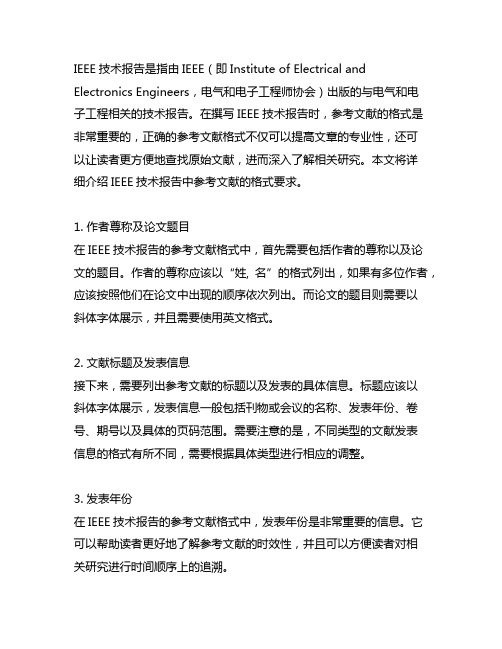
IEEE技术报告是指由IEEE(即Institute of Electrical and Electronics Engineers,电气和电子工程师协会)出版的与电气和电子工程相关的技术报告。
在撰写IEEE技术报告时,参考文献的格式是非常重要的,正确的参考文献格式不仅可以提高文章的专业性,还可以让读者更方便地查找原始文献,进而深入了解相关研究。
本文将详细介绍IEEE技术报告中参考文献的格式要求。
1. 作者尊称及论文题目在IEEE技术报告的参考文献格式中,首先需要包括作者的尊称以及论文的题目。
作者的尊称应该以“姓, 名”的格式列出,如果有多位作者,应该按照他们在论文中出现的顺序依次列出。
而论文的题目则需要以斜体字体展示,并且需要使用英文格式。
2. 文献标题及发表信息接下来,需要列出参考文献的标题以及发表的具体信息。
标题应该以斜体字体展示,发表信息一般包括刊物或会议的名称、发表年份、卷号、期号以及具体的页码范围。
需要注意的是,不同类型的文献发表信息的格式有所不同,需要根据具体类型进行相应的调整。
3. 发表年份在IEEE技术报告的参考文献格式中,发表年份是非常重要的信息。
它可以帮助读者更好地了解参考文献的时效性,并且可以方便读者对相关研究进行时间顺序上的追溯。
4. 期刊论文和会议论文的格式要求对于期刊论文,参考文献格式一般为:“作者. 文献题目, 期刊名称, 发表年份, 卷号(期号), 页码范围”。
而对于会议论文,参考文献格式一般为:“作者. 文献题目, 会议名称, 发表年份, 页码范围”。
5. 书籍和专著的格式要求对于书籍和专著,参考文献格式一般为:“作者. 书名, 出版地: 出版社, 出版年份”。
6. 网络资源的格式要求对于网络资源,参考文献格式一般为:“作者(若有). 文献题目, 全球信息站名称, 出版年份. [上线]. 可用: 全球信息站”。
7. 引用数字在IEEE技术报告中,引用数字也是常见的参考文献格式。
ieee论文格式

ieee论文格式IEEE已发展成为具有较大影响力的国际学术组织。
下面是由店铺整理的ieee论文格式,谢谢你的阅读。
ieee论文格式1、题目:应简洁、明确、有概括性,字数不宜超过20个字。
2、摘要:要有高度的概括力,语言精练、明确,中文摘要约100—200字;3、关键词:从论文标题或正文中挑选3~5个最能表达主要内容的词作为关键词。
4、目录:写出目录,标明页码。
5、正文:论文正文字数一般应在3000字以上。
论文正文:包括前言、本论、结论三个部分。
前言(引言)是论文的开头部分,主要说明论文写作的目的、现实意义、对所研究问题的认识,并提出论文的中心论点等。
前言要写得简明扼要,篇幅不要太长。
本论是论文的主体,包括研究内容与方法、实验材料、实验结果与分析(讨论)等。
在本部分要运用各方面的研究方法和实验结果,分析问题,论证观点,尽量反映出自己的科研能力和学术水平。
结论是论文的收尾部分,是围绕本论所作的结束语。
其基本的要点就是总结全文,加深题意。
6、谢辞:简述自己通过做论文的体会,并应对指导教师和协助完成论文的有关人员表示谢意。
7、参考文献:在论文末尾要列出在论文中参考过的专著、论文及其他资料,所列参考文献应按文中参考或引证的先后顺序排列。
8、注释:在论文写作过程中,有些问题需要在正文之外加以阐述和说明。
9、附录:对于一些不宜放在正文中,但有参考价值的内容,可编入附录中。
关于ieee的论文范文积极开展国际IEEE专业认证推进特色专业教育国际化摘要:培养国际化的高素质专业人才,推进特色专业教育国际化是教学改革所追求的目标之一。
为此,北京交通大学电子信息工程学院开展了通信工程、自动化两个本科专业的国际IEEE专业认证专家评估。
本文简要介绍了国际认证机构与ABET认证准则,分析对比了ABET认证准则与国内认证准则名称,并总结了参加IEEE专业认证工作的经验和体会,具有一定的借鉴和示范作用。
关键词:国际IEEE专业认证;教学改革;教育国际化;人才培养为了探索适应于高水平行业特色大学的国际化人才培养模式,促进北京交通大学工程教育和学科发展,提高专业的建设水平和国际竞争力,推进特色专业教育国际化,依托北京交通大学电子信息工程学院“通信工程”和“自动化”两个国家特色专业的学科优势,2011年5月,我校与IEEE国际认证委员会签署了合作备忘录,依据ABET专业认证准则,我校电子信息工程学院两个本科特色专业“通信工程”、“自动化”申报参加国际IEEE专业认证评估。
ieee 引用格式
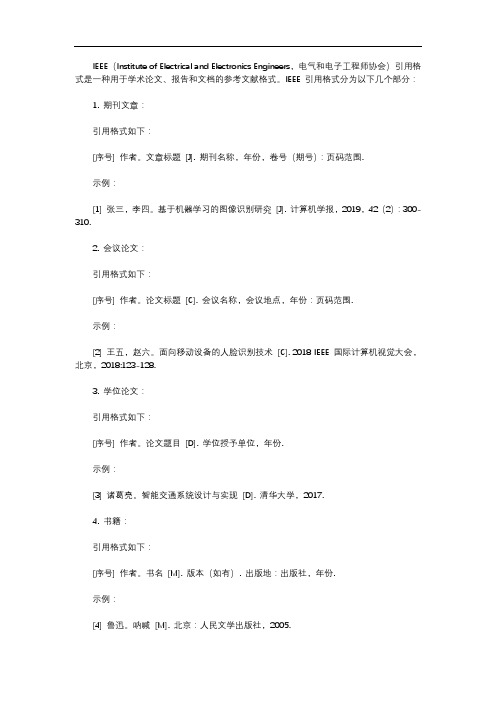
IEEE(Institute of Electrical and Electronics Engineers,电气和电子工程师协会)引用格式是一种用于学术论文、报告和文档的参考文献格式。
IEEE 引用格式分为以下几个部分:1. 期刊文章:引用格式如下:[序号] 作者。
文章标题[J]. 期刊名称,年份,卷号(期号):页码范围.示例:[1] 张三,李四。
基于机器学习的图像识别研究[J]. 计算机学报,2019,42(2):300-310.2. 会议论文:引用格式如下:[序号] 作者。
论文标题[C]. 会议名称,会议地点,年份:页码范围.示例:[2] 王五,赵六。
面向移动设备的人脸识别技术[C]. 2018 IEEE 国际计算机视觉大会,北京,2018:123-128.3. 学位论文:引用格式如下:[序号] 作者。
论文题目[D]. 学位授予单位,年份.示例:[3] 诸葛亮。
智能交通系统设计与实现[D]. 清华大学,2017.4. 书籍:引用格式如下:[序号] 作者。
书名[M]. 版本(如有). 出版地:出版社,年份.示例:[4] 鲁迅。
呐喊[M]. 北京:人民文学出版社,2005.5. 专利:引用格式如下:[序号] 发明人。
专利名称[P]. 国别:专利号,年份.示例:[5] 马云,杨过,张三丰。
一种分布式数据库系统[P]. 中国:ZL201710123456. 注意:- 序号:根据参考文献的类型,使用不同的序号,如:[1]、[2]、[3] 等。
- 引用格式中的各个部分需要按照相应规则缩进。
IEEE会议论文格式

Abstract—These instructions give you guidelines for preparing papers for the ICSGCE/IEEE conference. Use this document as a template by using Microsoft Word 6.0 or later. Otherwise, use this document as an instruction set. P lease use this document as a “template” to prepare your manuscript. For submission guidelines, follow the instructions on paper submission on /. Do not delete the blank line immediately above the abstract; it sets the footnote at the bottom of this column.Keywords-Component; formatting; style; styling; insertI.IntroductionThese guidelines include complete descriptions of the fonts, line spacing, margins, column widths, and related information for producing your manuscripts. If you are reading the ICSGCE-Template.doc, please save to your own conference directory for later use. Please follow them and if you have any questions, direct them to Publication Chair at ********************* or *********************.II.Procedure for Paper SubmissionA.Manuscript PreparingWhen you are preparing your manuscript, open the ICSGCE-Template.doc and rename it into yourown.doc. Then type over sections directly in the template, or simply cut and paste from another document and then format them by means of format paintbrush. Use italics for emphasis; do not underline. Do not change the font sizes, margins, column widths or line spacing to squeeze more text into a limited number of pages.You are also advised to follow the Manuscript received April 10, 2011. (Write the date on which you submitted your paper for review.) This work was supported in part by the U.S. Department of Commerce under Grant BS123456 (sponsor and financial support acknowledgment goes here). Paper titles should be written in uppercase and lowercase letters, not all uppercase. Avoid writing long formulas with subscripts in the title; short formulas that identify the elements are fine (e.g., "Nd–Fe–B"). Full names of authors are preferred in the author field, but are not required. Put a space between authors' initials.F. A. Author is with the National Institute of Standards and Technology, Boulder, CO 80305 USA (corresponding author to provide phone: 303-555-5555;fax:303-555-5555;e-mail:*******************.gov).S. B. Author, Jr. is with the Department of Physics, Colorado State University, Fort Collins, CO 80523 USA (e-mail: author@lamar. ).T. C. Author is with the Electrical Engineering Department, University of Colorado,Boulder,CO80309USA(e-mail:**************.jp).instructions on paper formatting on /. All manuscripts must be prepared in English.B.Paper SubmissionWhen you submit your manuscript, follow the instructions on paper submission on /and submit your papers online or via Email.Also send a Registration Form with complete contact information for all authors. Include full mailing addresses, telephone numbers, and e-mail addresses. In addition, designate one author as the “corresponding author.” This is the author to whom the notification of acceptance with revising requirements of the paper will be sent. The notification of acceptance is sent to the corresponding author only.C.Copyright FormAn ICSGCE/IEEE copyright form should accompany your final submission. These will be custom generated for you at the submission time. Authors are responsible for obtaining any security clearances.III.MathAll mathematical expressions must be legible. It is required to create equations or variables in your manuscript by the MathType. Size setting of equations is as follows:Full 10ptSubscript 7ptSub-subscript 6ptSymbol 12ptSub-symbol 8ptNumber equations consecutively with equation numbers in parentheses flush with the right margin, as in (1). To make your equations more compact, you may use the solidus ( / ), the exp function, or appropriate exponents. Use parentheses to avoid ambiguities in denominators. Punctuate equations when they are part of a sentence, as in220(,)/[/(2)]rF r dr d rϕϕσμ=⎰1120exp(||)()()j i iz z J r J r dλλλλλ∞-⨯--⎰ (1)Be sure that the symbols in your equation have been defined before the equation appears or immediately following.Refer to “(1),” not “Eq. (1)” or “equation (1),” except at the beginning of a sentence: “Equation (1) is ...”.• Italicize general variables (T might refer to temperature,Template for Preparation of Papers for ICSGCE/IEEE Conferences First A. Author, Second B. Author, Jr., and Third C. Author, Member, IEEEbut T is the unit tesla).• Denote vectors and matrices in bold but not italic Times New Roman.• Express derivatives as follows:2, not 2dx x b x x b dt=+=+ (2) • Half line spacing is suggested between the equation and its upper (lower) text as in (1) and (2).Do not give derivations that are easily found in the literature, merely cite the reference.IV. Figure and TableEach figure and table should have a caption to concisely and intelligibly illustrate the contents of it. Figures/tables may be worked into the text or placed at the end of the manuscript. To conserve space in the publication, most figures/tables are reduced to single-column width if possible. This may result in as much as a 4:1 reduction from the original. Therefore, figures/tables should be kept to a minimum in original and be easily viewed on published pages. Large figures and tables may span both columns.In the finalized sizes of figures/tables, authors are advised to make sure that (see Fig. 1):• All images/photographs will be published in black- and-white, so do not describe any of images/photographs with words such as red line, blue area, etc.• Graphing figures are recommended to generate in gray curves because some color lines will be not legible in black-and-white.• Lines in the figures are in 0.75 pounds and arrows in the minimum.• Mathematical expressions (variables) appearing in figures should be in the same styles as in texts (see Section III).• Trigram tables are suggested, as in Table 1, the first and the last lines are double lines and the 2nd line is in 0.75 pounds.• Texts in figures are approximately 8pt.• Captions of figures and tables are approximately 9pt. • Place figure captions below the figures, as in Fig. 1. • Place table titles above the tables, as in Table 1.The figures and tables are recommended to insert in your document after the text actually exists. Please do not include captions as part of the figures. Do not put captions in “t ext boxes” linked to the figures. Use the abbreviation “Fig.” even at the beginning of a sentence. Do not abbreviate “Tab.”. Tables are numbered with Arabic numerals.Table 1: The arrangement of channelsChannels Group 1 Group 2 … Group c Main channel Channel 1 Channel 2 … Channel c ………… …Fig. 1. Magnetization as a function of applied field. Note that “Fig.” is abbreviated. There is a period after the figure number, followed by two spaces. It is good practice to explain the significance of the figure in the caption. If your figure has two parts, include the labels “(a)” and “(b)” below the corresponding part of the figure. Then the figure caption should be “The significance of the figure: (a) the significance of (a) and (b) the significance of (b)”Figure axis labels are often a source of confusion. Use words rather than symbols. As an example, write the quantity “Magnetization,” or “Magnetization M ,” not just “M .” Put units in parentheses. Do not label axes only with units. As in Fig. 1, for example, write “Magnetization (A/m)” or “Magnetization (A ⋅m -1),” not just “A/m.” Do not label axes with a ratio of quantities and units. For example, write “Temperature (K),” not “Temperature/K.”Multipliers can be especially confusing. Write “Magnetization (kA/m)” or “Magnetization (103 A/m).” Do not write “Magnetization (A/m)⨯1000” because the reader would not know whether the top axis label in Fig. 1 meant 16000 A/m or 0.016 A/m.V. Helpful HintsEssentially, academic paper writing is as a form of problem-solving in which the writer, or the author, faces two main tasks: a) generating his academic ideas in language, and b) composing these ideas into a written structure to meet the need of readers and the requirements of the journal.Generally speaking, writing a good paper in English requires the mastery of various skills. It requires language basis, grammatical accuracy and readability, so that relationship between words and sentences are clear, and understanding between reader and writer is made easier. Additionally, it requires vocabulary appropriate to the subject matter and to the level and tone of the paper. Finally, of more importance, writing a good academic paper requires a careful and well-planned structuring of ideas.However, this Template is incapable to include everything you need to know to be a better writer. Given here are some useful language hints that should be an important part of resources for your paper writing. A. Formal Usages• Use one space after periods and colons.• Hyphenate complex modifiers: “zero -field-cooled magnetization.”• Prefixes such as “non,” “sub,” “micro,” “multi,” and“"ultra” are not independent words; they should be joined to the words they modify, usually without a hyphen.•Avoid dangling participles, such as, “Using (1), the potential was calculated.” [It is not clear who or what used (1).] Write instead, “The potential was calculated by using (1),” or “Using (1), we calculated the potential.”•A parenthetical statement at the end of a sentence is punctuated outside of the closing parenthesis (like this). (A parenthetical sentence is punctuated within the parentheses.) •Avoid contractions; for example, write “do not” instead of “don’t.” The serial comma is preferred: “A, B, and C” instead of “A, B and C.”B.Some Common Mistakes•The word “data” is plural, not singular.•The word “alternatively” is preferred to the word “alternately” (unless you really mean something that alternates).• Use the wo rd “whereas” instead of “while” (unless you are referring to simultaneous events).•Do not use the word “issue”or “question”as a euphemism for “problem.”• Be aware of the different meanings of the homophones “affect” (usually a verb) and “effect” (usua lly a noun), “complement” and “compliment,” “discreet” and “discrete,” “principal” (e.g., “principal investigator”) and “principle”(e.g., “principle of measurement”). Do not confuse “imply” and “infer.”•There is no period after the “et” in the Latin ab breviation “et al.” (It is also italicized).•The abbreviation “i.e.,” means “that is,” and the abbreviation “e.g.,” means “for example” (these abbreviations are not italicized).C.Abbreviations and AcronymsDefine abbreviations and acronyms the first time they are used in the text, even after they have already been defined in the abstract. Abbreviations such as TCP/IP, ac, and dc do not have to be defined. Do not use abbreviations in the title unless they are unavoidable.The abbreviation for “seconds” is “s,” not “sec.”D.UnitsUse SI not CGS as primary units. Avoid combining SI and CGS units. This often leads to confusion because equations do not balance dimensionally. If you must use mixed units, clearly state the units for each quantity in an equation.•Use the center dot to separate compound units, e.g., “A·m2.”•Indicate sample dimensions as “0.1 cm ⨯0.2 cm,” not “0.1 ⨯ 0.2 cm2.”•When expressing a range of values, write “7 to 9”or “7-9”, not “7~9”.Remember that an excellent academic paper needs to be composed by authors in good language! Undeciphe- rable English is a valid reason for rejection! If your native language is not English, please get a colleague good at English or a native English-speaker to proofread your paper.VI.References and CitationsNumber citations consecutively in square brackets [1]. The sentence punctuation follows the brackets [2]. Multiple references [2], [3] are each numbered with separate brackets [1]–[3]. When citing a section in a book, please give the relevant page numbers [2]. In sentences, refer simply to the reference number, as in [3]. Do not use “Ref. [3]” or “reference [3]” except at the beginning of a sentence: “Reference [3] shows ... .” The conference cannot accept footnotes in its document; therefore, type the reference list at the end of the paper using the “References” stylePlease note that the references at the end of this document are in the preferred referencing style. Give all authors’ names; do not use “et al.” unless there are six authors or more. Use a space after authors' initials. Papers that have not been published should be cited as “unpublished” [4]. Papers that have been submitted for publication should be cited as “submitted for publication” [5]. Papers that have been accepted for publication, but not yet specified for an issue should be cited as “to be published” [6]. Please give affiliations and addresses for private communications [7]. Capitalize only the first word in a paper title, except for proper nouns and element symbols. For papers published in translation journals, please give the English citation first, followed by the original foreign-language citation [8].VII.ConclusionA conclusion section is not required. Although a conclusion may review the main points of the paper, do not replicate the abstract as the conclusion. A conclusion might elaborate on the importance of the work or suggest applications and extensions.VIII.AppendixAppendixes, if needed, appear before the acknowledgment.IX.AcknowledgmentUse the singular heading even if you have many acknowledgments. Avoid expressions such as “One of us (S.B.A.) would like to thank ... .” Instead, write “F. A. Author thanks ... .” Sponsor and financial support acknowledgments are placed in the unnumbered footnote on the first page.References[1]G. O. Y oung, “Synthetic structure of industrial plastics (Book stylewith paper title and editor),” in Plastics, 2nd ed. vol. 3, J. Peters, Ed.New York: McGraw-Hill, 1964, pp. 15–64.[2]W.-K. Chen, Linear Networks and Systems (Book style).Belmont, CA:Wadsworth, 1993, pp. 123–135.[3] H. Poor, An Introduction to Signal Detection and Estimation. NewYork: Springer-Verlag, 1985, ch. 4.[4] B. Smith, “An approach to graphs of linear forms (Unpublished workstyle),” unpublished.[5] E. H. Miller, “A note on reflector arrays (Periodical style—Acceptedfor publication),” IEEE Trans. Antennas Propagat., to be published.[6]J. Wang, “Fundamentals of erbium-doped fiber amplifiers arrays(Periodical style—Submitted for publication),” IEEE J. QuantumElectron., submitted for publication.[7] C. J. Kaufman, Rocky Mountain Research Lab., Boulder, CO, privatecommunication, May 1995.[8]Y. Yorozu, M. Hirano, K. Oka, and Y. Tagawa, “Electron spectroscopystudies on magneto-optical media and plastic substrate interfaces(Translation Journals style),”IEEE Transl. J. Magn.Jpn., vol.2, Aug. 1987, pp. 740–741 [Dig. 9th Annu. Conf. Magnetics Japan, 1982, p. 301].[9]M. Young, The Techincal Writers l Valley, CA:University Science, 1989.[10]J. U. Duncombe, “Infrared navigation—Part I: An assessment offeasibility (Periodical style),” IEEE Trans. Electron Devices, vol.ED-11, pp. 34–39, Jan. 1959.[11]S. Chen, B. Mulgrew, and P. M. Grant, “A clustering technique fordigital communications channel equalization using radial basisfunction networks,” IEEE Trans. Neural Networks, vol. 4, pp. 570–578, July 1993.[12]R. W. Lucky, “Automatic equalization for digital communication,”Bell Syst. Tech. J., vol. 44, no. 4, pp. 547–588, Apr. 1965.[13]S. P. Bingulac, “On the compatibility of adaptive controllers (PublishedConference Proceedings style),” in Proc. 4th Annu. Allerton Conf.Circuits and Systems Theory, New York, 1994, pp. 8–16.[14]G. R. Faulhaber, “Design of service systems with priority reservation,”in Conf. Rec. 1995 IEEE Int. Conf. Communications, pp. 3–8. [15]W. D. Doyle, “Magnetization reversal in films with biaxial anisotropy,”in 1987 Proc. INTERMAG Conf., pp. 2.2-1–2.2-6.[16]G. W. Juette and L. E. Zeffanella, “Radio noise currents n short sectionson bundle conductors (Presented Conference Paper style),” presente d at the IEEE Summer power Meeting, Dallas, TX, June 22–27, 1990,Paper 90 SM 690-0 PWRS. [17]J. G. Kreifeldt, “An analysis of surface-detected EMG as anamplitude-modulated noise,” presented at the 1989 Int. Conf. Medicine and Biological Engineering, Chicago, IL.[18]J. Williams, “Narrow-band analyzer (Thesis or Dissertation style),”Ph.D. dissertation, Dept. Elect. Eng., Harvard Univ., Cambridge, MA, 1993.[19]N. Kawasaki, “Parametric study of thermal and chemicalnonequilibrium nozzle flow,” M.S. thesis, Dept. Elec tron. Eng., Osaka Univ., Osaka, Japan, 1993.[20]J. P. Wilkinson, “Nonlinear resonant circuit devices (Patent style),”U.S. Patent 3 624 12, July 16, 1990.[21]IEEE Criteria for Class IE Electric Systems (Standards style), IEEEStandard 308, 1969.[22]Letter Symbols for Quantities, ANSI Standard Y10.5-1968.[23]R. E. Haskell and C. T. Case, “Transient signal propagation in losslessisotropic plasmas (Report style),” USAF Cambridge Res. Lab., Cambridge, MA Rep. ARCRL-66-234 (II), 1994, vol. 2.[24] E. E. Reber, R. L. Michell, a nd C. J. Carter, “Oxygen absorption in theEarth’s atmosphere,” Aerospace Corp., Los Angeles, CA, Tech. Rep.TR-0200 (420-46)-3, Nov. 1988.[25](Handbook style) Transmission Systems for Communications, 3rd ed.,Western Electric Co., Winston-Salem, NC, 1985, pp. 44–60.Motorola Semiconductor Data Manual,Motorola Semiconductor Products Inc., Phoenix, AZ, 1989.[26](Basic Book/Monograph Online Sources) J. K. Author. (year, month,day). Title (edition) [Type of medium]. Volume(issue). Available:http://www.(URL)[27]J. Jones. (1991, May 10). Networks (2nd ed.) [Online]. Available:[28](Journal Online Sources style) K. Author. (year, month). Title. Journal[Type of medium]. Volume(issue), paging if given. Available:http://www.(URL)[29]R. J. Vidmar. (1992, August). On the use of atmospheric plasmas aselectromagnetic reflectors. IEEE Trans. Plasma Sci. [Online]. 21(3).pp. 876—880. Available: /pub/journals/ 21ps03-vidmar。
ieee论文格式中文

ieee论文格式中文推荐文章•sci论文翻译成中文论文格式热度:•初一政治小论文格式范文热度:•初中科学发展小论文格式范文热度:•初中历史小论文格式范文热度:•本科毕业论文格式模板2017年热度:ieee论文格式中文IEEE一直致力于推动电工技术在理论方面的发展和应用方面的进步。
下面是由店铺整理的ieee论文格式,谢谢你的阅读。
ieee论文格式1、题目:应简洁、明确、有概括性,字数不宜超过20个字。
2、摘要:要有高度的概括力,语言精练、明确,中文摘要约100—200字;3、关键词:从论文标题或正文中挑选3~5个最能表达主要内容的词作为关键词。
4、目录:写出目录,标明页码。
5、正文:论文正文字数一般应在3000字以上。
论文正文:包括前言、本论、结论三个部分。
前言(引言)是论文的开头部分,主要说明论文写作的目的、现实意义、对所研究问题的认识,并提出论文的中心论点等。
前言要写得简明扼要,篇幅不要太长。
本论是论文的主体,包括研究内容与方法、实验材料、实验结果与分析(讨论)等。
在本部分要运用各方面的研究方法和实验结果,分析问题,论证观点,尽量反映出自己的科研能力和学术水平。
结论是论文的收尾部分,是围绕本论所作的结束语。
其基本的要点就是总结全文,加深题意。
6、谢辞:简述自己通过做论文的体会,并应对指导教师和协助完成论文的有关人员表示谢意。
7、参考文献:在论文末尾要列出在论文中参考过的专著、论文及其他资料,所列参考文献应按文中参考或引证的先后顺序排列。
8、注释:在论文写作过程中,有些问题需要在正文之外加以阐述和说明。
9、附录:对于一些不宜放在正文中,但有参考价值的内容,可编入附录中。
关于ieee的论文范文探讨基于IEEE 802.11标准无线局域网(WLAN)的安全漏动与防治对策摘要:本文主要对基于IEEE 802.11标准无线局域网的安全漏动与防治对策进行了论述,以供同仁参考。
关键词:IEEE 802.11;无线局域网;安全漏动;防治对策中图分类号:F764.6 文献标识码:A 文章编号:一、前言随着无线局域网的迅猛发展,其安全问题也日益受到人们的关注,由于数据无线传输,所以窃听、身份信息篡改等攻击对无线局域网构成了严重的威胁,该问题能否得到比较完善的解决,成为无线局域网获得更大应用及推广的关键因素。
- 1、下载文档前请自行甄别文档内容的完整性,平台不提供额外的编辑、内容补充、找答案等附加服务。
- 2、"仅部分预览"的文档,不可在线预览部分如存在完整性等问题,可反馈申请退款(可完整预览的文档不适用该条件!)。
- 3、如文档侵犯您的权益,请联系客服反馈,我们会尽快为您处理(人工客服工作时间:9:00-18:30)。
CSO 2010投稿论文写作要求(IEEE CS格式)0. 特别提示:请大家使用IEEE CS最新版的两栏格式模板进行排版格式处理,同时考虑将论文压缩在IEEE CS的5页之内,如超过5页,超出页数将会加收额外费用。
下面是一些中国作者排版时应该注意的问题,请准备论文投稿时注意。
1. 标题(Title):标题又称题目,是以最恰当、最简明的词语反映论文中最重要的特定内容的逻辑组合。
论文题目是一篇论文给出的涉及论文范围与水平的第一个重要信息。
论文题目十分重要,必须用心斟酌选定,有人说:好的论文题目是好文章的一半。
对论文题目的要求是:准确得体、简短精炼、外延和内涵恰如其分、醒目。
在CSO2010的会议论文中,请使用14点(14-point)粗体罗马字(Time New Roman, boldface type),标题应居中显示,每个实词(包括名词、代词、动词、形容词和副词)的首字母应该大写,虚词(包括冠词、连词、介词等),注意如果虚词是标题的首个单词,也应该大写,如“A Support Vector Machines Method for Classification Problem”,标题之后留一个10点字体的空行。
另外,根据以前会议审稿结果,一些标题中还有“Study on”或者“Research on”类似的词,应该全部去掉,审稿人认为那些是典型的中国式英语翻译,为了顺利帮助检索,英文的写作应该更符合英文的习惯。
注意:标题字体应该严格按照修改要求来做,不要擅自更改标题字体。
特别长的标题宜分成2行或者3行,如果距离过宽,请修改段前距离(在word的“格式--段落”菜单中可以修改段前段后距离),这样就可以缩小行距。
尽量用“Times New Roman”,不要对这个字体进行压缩。
此外,首页标题不要用下标,表示基金感谢放在Conclusion之后和“References”之前,设置“Acknowledgment”一节,对一些基金支持和别人提供的帮助等表示感谢。
2. 作者姓名和单位: 这一项属于论文署名问题。
署名一是为了表明文责自负,二是记录作用的劳动成果,三是便于读者与作者的联系及文献检索(作者索引)。
在CSO2010的论文中,作者姓名应该放在论文标题下方,居中用11点字体显示,不要加粗体。
论文有多个作者时,可以用分2或3列的方式来显示。
作者单位和email地址应该在作者下方,使用10点罗马字。
在作者信息下面保留2个10点字体的空行。
对于中国作者,要使用“名+姓”的格式写作者的名字,否则的话在检索数据库里面出错。
例如,有个叫张三的中国作者,如果他的署名是 Zhang San,因为检索机构是国外的,国外都是名前姓后的方式,检索到数据库中就是San Z.,名经常被缩写为一个字母。
所以务请各位作者注意。
注意:作者的排列问题主要是多个作者出现的问题,大家可以按照下面几个原则来做:(a) 如果2个或多个作者属于同一个单位,那就按照一栏格式,每个作者用逗号隔开:Sanfeng Zhang, Sihai Li, Wuyi WangDepartment of Computer Sciences, Beijing University, Beijing, 100110, ChinaE-mail: sfzhang@(b) 如果2个或多个作者属于分属不同单位,那就按照下面的格式,利用表格来分栏,表格线变虚线即可实现。
Sanfeng Zhang Liuxing Zhao Qiutian QianDepartment of Computer Science, Beijing University,Beijing, 100110, ChinaE-mail: sfzhang@School of Computing,Tsinghua UniversityBeijing, 100084, ChinaE-mail: xzhao@Faculty of Business,Harvard University,Washington, 003-24, USAE-mail: qtqian@(c) 如果多个作者中,几个属于一个单位,另外几个属另一个不同单位,那就按照下面的格式,利用表格来分栏,表格线变虚线即可实现。
Sanfeng Zhang, Sihai Li Liuxing Zhao Qiutian Qian, L. ZadehDepartment of Computer Science, Beijing University,Beijing, 100110, ChinaE-mail: sfzhang@School of Computing,Tsinghua UniversityBeijing, 100084, ChinaE-mail: xzhao@Faculty of Business,Harvard University,Washington, 003-24, USAE-mail: qtqian@(d) 如果是4个作者或更多作者属于4个以上不同单位,那就变成4行2列或者6行2列,如下所示:Sanfeng Zhang Liuxing ZhaoDepartment of Computer Science, Beijing University,Beijing, 100110, ChinaE-mail: sfzhang@School of Computing, Tsinghua University Beijing, 100084, China E-mail: lxzhao@Liuxing Zhao Qiutian QianSchool of Computing, Tsinghua University Beijing, 100084, China E-mail: lxzhao@Faculty of Business,Harvard University, Washington, 003-24, USA E-mail: qtqian@另外,作者的Email不要让它有下划线。
3. 摘要(Abstract):摘要是论文内容不加注释和评论的简短陈述,是可以帮助读者不阅读论文全文即能获得必要的信息。
下面总结了一篇好的学术论文摘要的基本要求,具体可参见示例。
需重视的是,IEEE要求摘要限制在200个单词以内,但是字数也不宜太少。
【摘要实例】标题:Variable precision rough set for multiple decision attribute analysis英文版摘要: [Purpose] In order to solve the multi-attribute decision analysis (MADA) problem with multiple conflicting decision attributes and multiple condition attributes, a variable precision rough set (VPRS) model is used in this paper. [Method] By introducing confidence measure and β-reduct, the VPRS model can rationally solve the conflicting decision analysis problem with multiple decision attributes and multiple condition attributes. For illustration, a medical diagnosisexample is utilized to show the feasibility of the VPRS model in solving MADA problem withmultiple decision attributes and multiple condition attributes. [Results] Empirical results show that the decision rule with highest confidence measure will be used as the final decision rules in the MADA problem with multiple conflicting decision attributes and multiple condition attributes if there are some conflicts among decision rules resulting from multiple decision attributes. [Conclusions] The confidence-measure-based VPRS model can effectively solve the conflicts of decision rules from multiple decision attributes and thus a class of MADA problem with multiple conflicting decision attributes and multiple condition attributes are solved.对应的中文版:标题:基于变精度粗糙集的多决策属性分析【中文版摘要】[目的]为了处理多个决策属性之间的冲突,利用一个变精度粗糙集模型解决了具有多决策属性和多条件属性的决策分析问题。
[过程和方法]通过引入置信测度和β-约简规则,变精度粗糙集模型能够合理地处理多个决策属性之间的冲突问题。
为解释这个模型的实施,一个医疗诊断的实例被采用。
[结果] 实例的分析表明:在具有多决策属性和多条件属性的决策分析问题中,如果利用β-约简规则从多个决策属性之中提取的决策规则之间存在冲突,则置信测度水平较高的决策规则将作为最终的决策依据。
[结论] 这个基于置信测度的变精度粗糙集模型能够有效地解决多个决策属性引致的决策规则之间的冲突,从而解决了一类具有多决策属性和多条件属性的决策分析问题。
注意,IEEE新版的模板里面要求有关键词,可设3-5个关键词,最多不要超过6个。
另外,摘要内容和关键词均为9点罗马字,其中摘要为粗体,关键词为斜体。
4. 引言(Introduction):引言又称前言,属于整篇论文的引论部分。
其写作内容包括:研究的理由、目的、背景、前人的工作和知识空白,理论依据和实验基础,预期的结果等。
